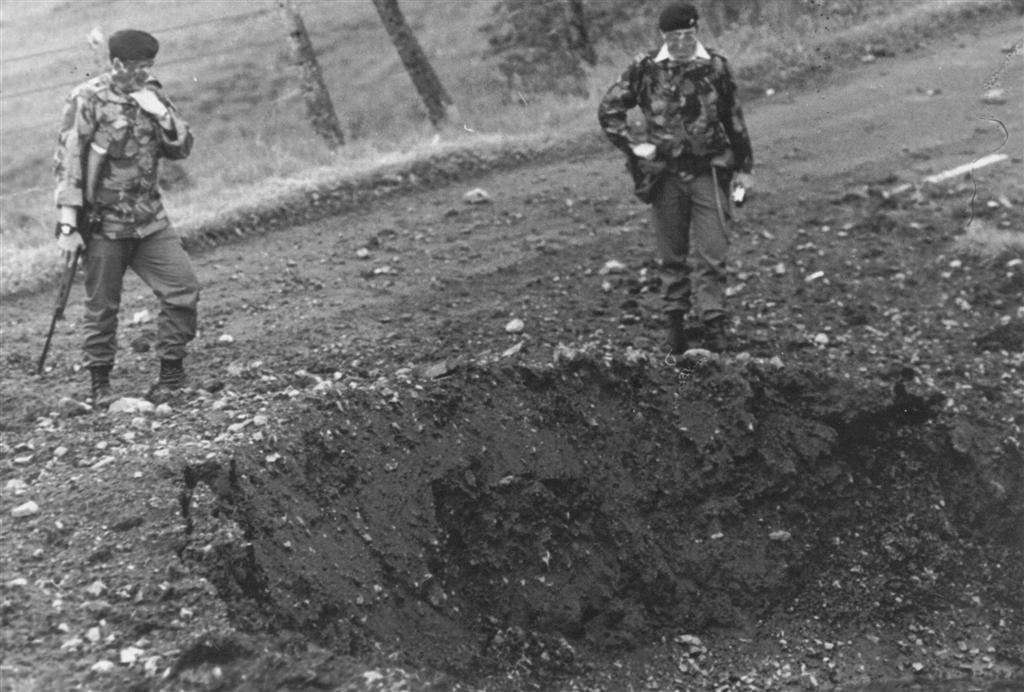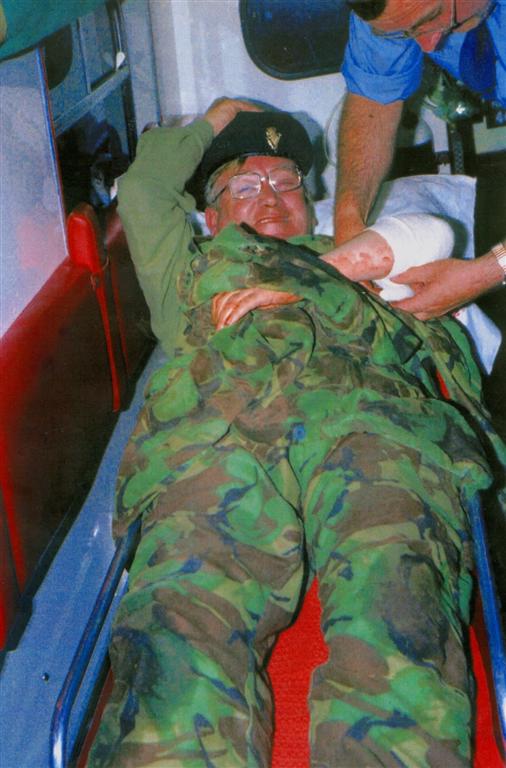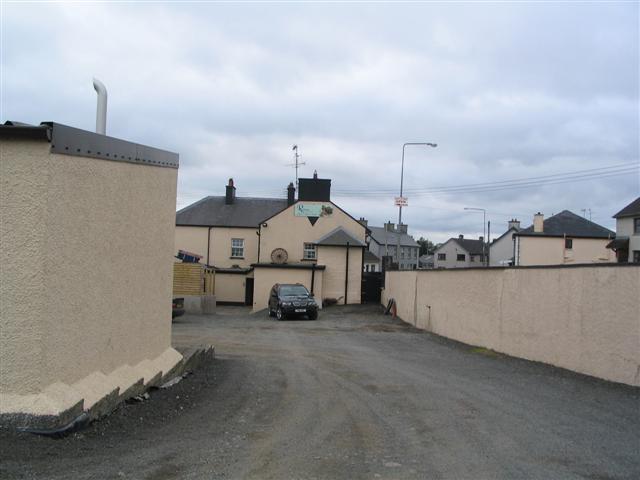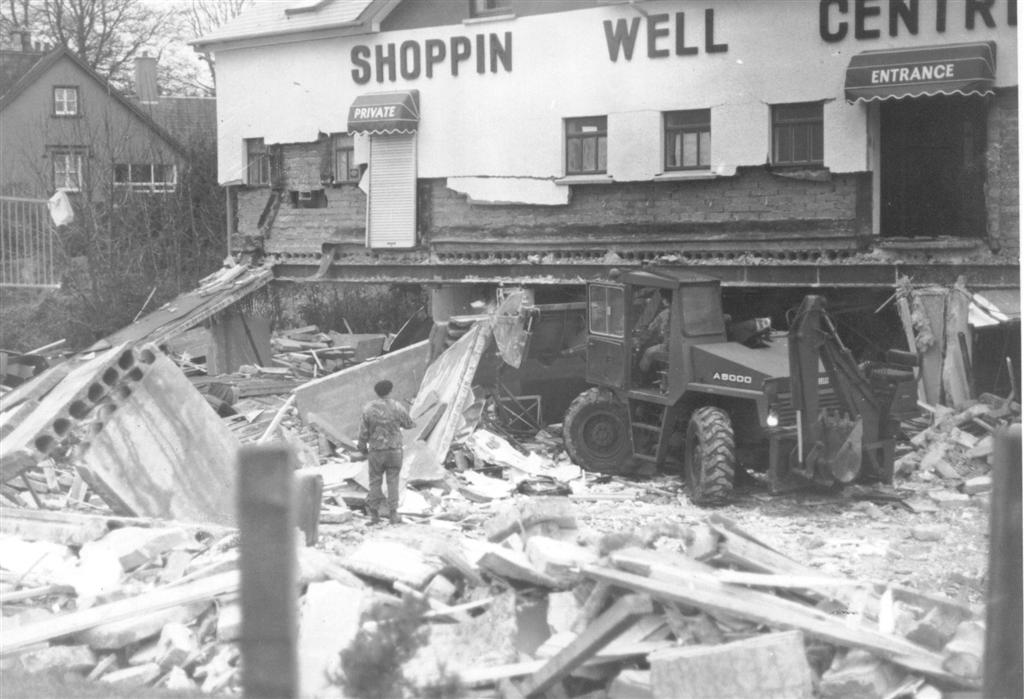Previous
Chapter Chapter
9 - E Company – The Middle Years (1980s)
Terrorist
Activity
The
Maghera Bomb Blitz
“In
1980 it was decided that the UDR should expand its area of
responsibility to cover the security of South Londonderry. The
area extended just north of Cookstown to the area north of
Garvagh. The Commanding Officer at the time was Lt. Col. Hugh
Tarver, a thoroughly professional and competent Regular
Officer. The Commanding Officer decided that I should be posted
as the Operations Officer based at Magherafelt.
Two days after I was appointed as Operations Officer the
IRA put five bombs into the town of Maghera and I got a phone
call quite early in the morning to say that there was an
incident in Maghera. I travelled from my home to Maghera and
when I got to within one and a half miles of the village the
hot ashes were landing on the roof of my car. I could see the
whole town was ablaze from one end to the other.
A store in Lower Main Street Maghera contained a large
quantity of gas cylinders and these had gone up and were
blowing the slates off the roofs. I walked down to the junction
of Main Street and Hall Street in Maghera and spoke to the
sentry posted at the end of the street.
I then left that position and drove to Magherafelt.
Later on I found something uncomfortable in my right foot, I
took off my shoe and I found that a sliver of wood from the
explosions had entered just below the sole of my foot. If it
had of been a fraction of an inch higher it would have gone
through my foot.
I met the Commanding Officer in Maghera later on and he
said, ‘This is marvellous’. I thought it was disastrous.
‘Not at all’, he said, ‘This is just what we need. This
shows we can cope’ S4.
The
Mid Ulster Murders
On
12 September 1981 Private Alan Clarke, a 20 year-old Permanent
Cadre soldier from Upperlands was murdered by Republican gunmen
as he walked along Hall Street in Maghera. One of his
pallbearers on 14 September was Reserve Constable Johnnie
Proctor, a former member of the Garvagh Detachment.
A few hours later Johnnie Proctor visited his wife and
newborn son in the Mid Ulster Hospital in Magherafelt. He was
shot dead as he returned to his car.
Contact
at the Pot
“It
was 25th June 1982. A multiple patrol of five teams
from 21 Platoon was operating in the Garvagh area. I was the
driver of one of the Landrovers. It was a wet summer night but
quite warm.
Two
teams left their Landrovers in Garvagh RUC station and we took
them in our vehicles to the Garvagh Glen. They were dropped off
and conducted snap VCP’s (Vehicle Check Points) on foot for a
few hours. The remaining three Landrovers worked in the
Dungiven area. It was a good nights work as usual for 21
Platoon with plenty of good craic. We had lots of VCP
data sheets completed for each vehicle stopped and searched.
At around 2am we left the Dungiven area and moved
towards Garvagh on the Legavallon Road to pick up the two Foot
Patrols. We were in the last vehicle. Corporal Jamieson said to
me, “Get the fags out young man”. The next thing I knew
there was a white flash and the Landrover lifted about ten feet
in the air. Somebody shouted, ‘F*** me, we’re all dead!’
Large rocks and boulders were raining down on us and all the
windows were blown in. I managed to turn the steering wheel
before the Landrover landed so we ran into the banking instead
of rolling down the 300m. slope.
Corporal Ted Jamieson shouted, ‘All out into cover.
Put fire down on the high ground!’ I jumped out and into the
ditch with my heart pounding. I emptied a magazine in no time,
firing along the skyline of the high ground. Tracer rounds and
illuminating rockets lit up the morning sky.
After detonating the 500lb landmine the terrorists had
escaped by car. There was a hole in the road you could have
fitted our three Landrovers in. We cordoned off the area and
for the safety of the road users we diverted all the traffic.
At 7am the full-time soldiers came out to take over the cordon
positions. I had to set off straight away to my normal day job,
which began at 8am. Just another night for 21 Platoon and then
my civilian boss complained that I was 15 minutes late for
work” S51.
Photo 29 The Bomb Crater on the Legavallon Road

The
Sandy Baxter Incident
“One
October night in 1982 we were patrolling in the Swatragh area
when we saw a well-known terrorist’s car sitting by the side
of the road near a garage. As we inspected the car the owner
came forward with the excuse that he had run out of petrol.
Three nights later at the same spot Sandy Baxter was
shot in the elbow. He was on vehicle patrol with his elbow
resting on the windowsill of the Landrover, smoking, when the
attack started. If his elbow had been inside the vehicle he
would have escaped injury.
Photo 30 Sandy Baxter after the Incident

We drove out of the killing zone until we reached the
Garvagh Road and Sandy was the most injured. Stone chips of the
terrorist bullets had also ricocheted off the road surface and
splattered others on the patrol. In fact some of the leaf
springs of the Landrover had bullet holes.
There
were at least four gunmen involved in this failed murder
attempt. It was a miracle that no one was killed. It was a
typical ‘shoot and scoot’ on the terrorist part.
After that we used other methods to get through
Swatragh. Some Regular units ignored the threat and paid the
price when they fell victim to a horizontal mortar attack.
There
was a popular TV show at that time called Dallas and the topic
was, ‘Who shot JR’. As part of the following Thursday night
celebration in the Junior Ranks club, we had a run of T-shirts
with the logo, ‘Who Shot Sandy Baxter?’ on the front” S
18.
The
Swatragh Ambush
On
the night of 8 November 1982 the Commander Land Forces, General
Chiswell, and the UDR Commander, Brigadier Graham, visited the
5th Battalion. It was almost one month after Sandy
Baxter was shot. That night two Republican gunmen tried again
to murder members of an E Company patrol as it passed through
Swatragh village.
“We
travelled through the village of Swatragh and just as the
leading Landrover crossed the bridge over the small river
running through the village, there were two or three bursts of
automatic gunfire – rat-a-tat-tat, rat-a-tat-tat.
Instinctively I ordered the driver to stop, which he did rather
quickly. The rear vehicle pulled up about 30 yards behind us.
We all used the parapet of the bridge as cover and a
young soldier from the rear vehicle reported the flashes of the
terrorist weapons. The Corporal in charge of the rear vehicle
gave a fire control order and the section returned fire on the
terrorist position with the aid of illuminating flares. These
engagements with terrorists are known as contacts and I
immediately got on the radio and put in a ‘Contact Report to
Magherafelt Operations room. The Duty officer in Magherafelt
then alerted all the support agencies to be on stand by to be
tasked to our location.
As soon as I realised we were no longer being fired on I
ordered ‘Cease Fire!’ I then checked my men in both
vehicles. We were lucky no one was injured but a terrorist
bullet had hit the flash eliminator of one of my soldier’s
rifles and the muzzle was blown apart. That young soldier came
within inches of being killed or seriously injured that
night”
We had Nightsun, the helicopter with a searchlight, the
RUC Scenes of Crime Officer (SOCO) and other support agencies
on hand within a short time” S3.
“Our
patrol left Garvagh ten minutes after the Coleraine patrol and
we followed the same route. As we travelled towards Swatragh at
the Craigavole area the radio operator said to me, ‘What kind
of things are those flying through the air? Are they shooting
stars?’
The driver Bertie Gilmore and myself looked in the
direction she indicated and we both saw the tracer rounds
leaving their track in the sky. The rounds were at the same
height as the telegraph poles and were coming in our direction.
If they had been any lower they would have hit us.
The driver accelerated the Landrover forward to the
crest of the hill in front of Swatragh village. By this time
the firing had stopped. At that point the area was lit up by
the village streetlights so we stopped just short of that area.
We dismounted and left the two drivers in charge of security of
their vehicles and went forward. As we ran forward towards
Swatragh we saw the silhouette of a person running across the
road from the location of the telephone exchange to the back of
The Rafters public house.

The back of The Rafters public house
I checked my observation with the soldier on the other
side of the road and he confirmed my sightings. We continued
our advance as far as the back yard of The Rafters bar because
that was the most likely location of the person we saw earlier.
There was a touring caravan in the yard with all its
lights on and the female occupant was standing at the door. She
was shouting continuously at the patrol with foul obscenities.
We knew this was her way of decoying us from our immediate job,
finding the runner. Her distractions did not work and we
continued our search, still not fully aware of what had
actually taken place.
One of the soldiers posted in the yard said that the
door to an outhouse had been open. It had been open when the
patrol first entered the yard. Now it was closed. I immediately
had the outhouse surrounded by the patrol using defensive
positions in case anyone bolted out from the outhouse.
With the outhouse covered, I went forward and opened the
door and shone a torch in. There was a man crouched against the
wall, cowering with his hands covering his face. His feet were
on a loaded rifle. I called the patrol forward so that we
closed in on the individual. I reached in and grabbed the
individual and dragged him from the outhouse. He lay on the
ground and refused to move. It was quite obvious he was
petrified. We questioned the individual and all the information
was false because we knew the area very well.
We handed the individual and his rifle over to the RUC.
Once the police left the scene I reorganized the patrol and
carried out a detailed search of the immediate area. We found
the firing point used by the terrorist to attack the patrol.
This was located in an alley beside the car showroom in the
middle of Swatragh.
A terrorist had engaged the rear Landrover of the patrol
going through the middle of the village. One of his shots had
split the flash eliminator on the end of the soldiers SLR where
he sat in the back of the Landrover.” S9.
The
‘Droppin Well Inn’ Atrocity
The following month, on 6 December 1982, E Company was involved in the follow-up operation in Ballykelly where seventeen people were murdered in a Republican bomb attack. The casualties were mostly off duty soldiers and locals who had been drinking in a local bar and disco near their Ballykelly base. Over 150 people were also injured, 30 of them seriously. The photo shows the clean up operation the following morning.

Freedom
of Coleraine
“One
of the highlights of my service, and there were many, came when
the Regiment was granted the Freedom of the Borough of
Coleraine in March 1981. I commanded a guard of honour from the
Battalion which represented the Regiment and paraded to the
Town Hall in Coleraine for inspection by the Mayor and after a
ceremony at the Council Headquarters we held a party for all
ranks at Laurel Hill House in the evening – it was a superb
occasion.
The officers that day carried swords. We had seldom
practiced sword drill until then. Many hours were spent at
Ballykelly practicing our foot drill, arms drill and sword
drill. After the Freedom parade everyone on the Guard of Honour
felt very proud that we had achieved such a high standard and
had been a credit to the Regiment” (Hamill, 2007).
Laurel
Hill Arms Raid
On the night of 22 February 1987 E Company Armoury
storeman smuggled three men into the Coleraine camp in the boot
of his car. Later that night the three men overpowered the
guard and ‘forced’ the storeman to hand over the armoury
keys. All the company weapons including 144 SLRs, two Light
Machine Guns (LMGs), twenty-eight pistols and over a thousand
rounds of ammunition were loaded onto a van and the group made
their escape.
The van was intercepted within one hour of the alarm
being raised by a soldier coming on duty who was unable to gain
access to the camp.
Even after a consideration of the security lapses
and other factors not discussed here, the central question
still remains, why was it allowed to happen?
Soldiers
Attitudes to Loyalist Terrorists
“There
were a couple of incidents where Loyalist terrorist activity
compromised the UDR. Some of the soldiers who tried to confront
the Loyalist terrorists during one incident were left in no
doubt that their lives were in danger if they did not shut up.
Many soldiers did not talk about incidents like that.
These were difficult times for the majority of the soldiers
because it was impossible to tell who was involved. You can
lose your trust for your fellow soldiers. It was not safe to
openly voice your opposition to Loyalist terrorism when you
lived in a predominately Protestant community. If the Loyalist
terrorists could overpower an armed guard, what chance did you
stand in your own community?” S25
Terrorist
Security
The
RUC Information Office released a table called ‘Policing
Efficacy, 1981–1987’. But, more than reflect RUC
competence, it probably reflects the relative ability of each
terrorist group to maintain their security. The table shows
that over the six-year period the Republican terrorists
murdered 386 people and one person was charged for every three
murders. The Loyalist terrorists murdered 69 people and five
people were usually charged for every three murders.
The
Collapse of Communism
The
Republican movement received another credibility test in 1989.
When the Provisional IRA (PIRA) split from the Official IRA in
1969 they rejected the Officials brand of Marxism but continued
to identify themselves as both non-sectarian and socialist
Republicans. When the Berlin Wall crashed down in 1989 so did
socialism, the PIRA’s non-sectarian facade.
Previous
Chapter Chapter
9 - E Company – The Middle Years (1980s)